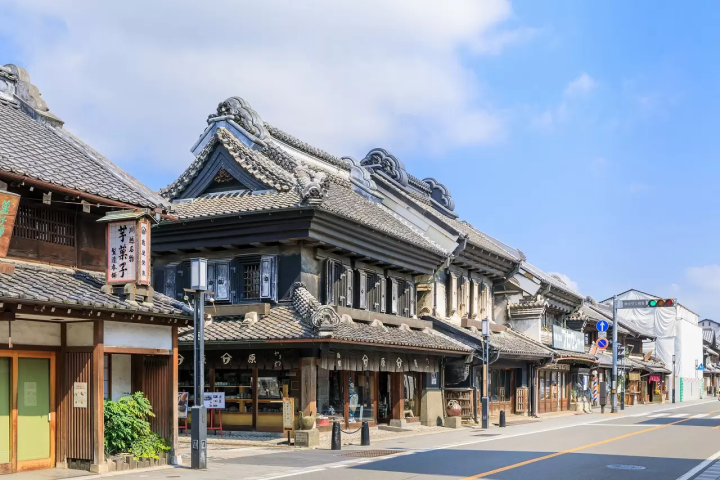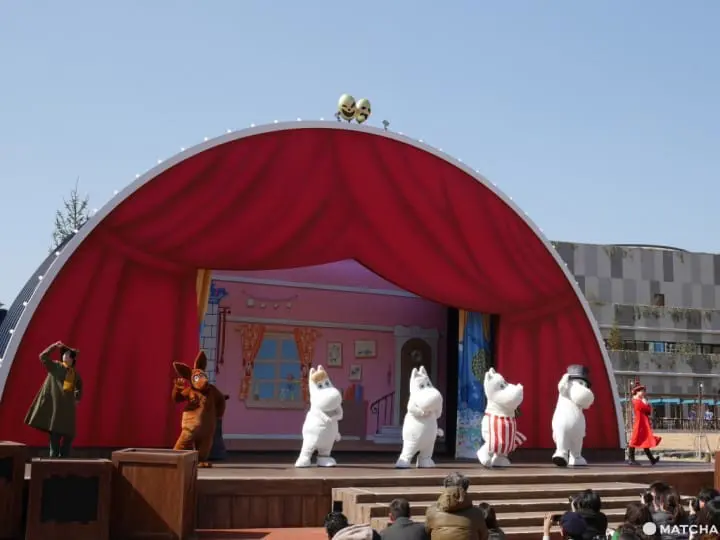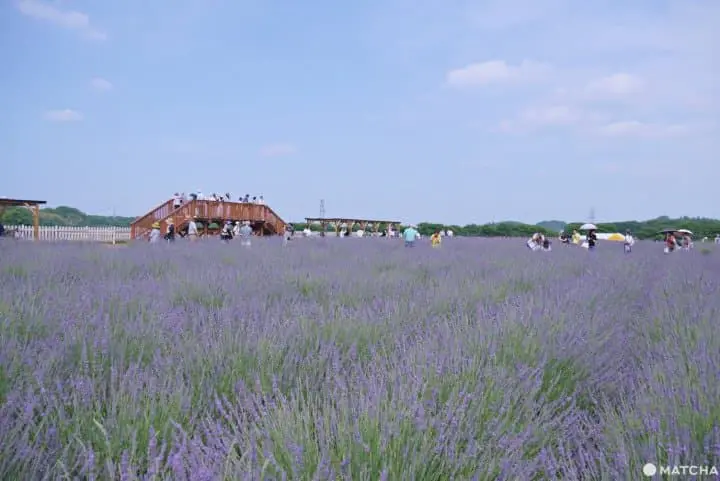Saitama: Top 12 Things to Do on a Day Trip From Tokyo

Cities like Kawagoe, Chichibu, or Omiya in Saitama Prefecture are excellent Tokyo day trip destinations. This article features fun things to do and places to visit in Saitama, including nature-rich destinations, historical sites, amusement parks, and museums.
Saitama: Home to Excellent Tokyo Day Trip Destinations
Saitama, the prefecture bordering Tokyo to the north and west, boasts a number of little-known yet incredibly appealing tourist attractions.
This article features 12 fun things to do and places to visit in Saitama alongside local food recommendations. All these destinations are ideal for day trips from Tokyo.
Top 12 Things to Do in Saitama
1. Kawagoe: See Traditional Townscapes
2. Nagatoro and Chichibu: Splendid Mountain Scenery
3. Tove Jansson Akebono Children's Forest Park
4. Moominvalley Park and metsä village
5. Omiya Bonsai Art Museum
6. Iwatsuki Ningyo Japanese Doll Museum
7. Metropolitan Area Outer Underground Discharge Channel
8. The Railway Museum in Omiya
9. Kadokawa Culture Museum in Tokorozawa
10. Sennen no Sono Lavender Field
11. Heirinji Temple: A Famous Fall Foliage Spot
12. Johnson Town: A District with an American Flair
Must-Try Saitama Food Specialties
1. Kawagoe: See Traditional Townscapes

Photo by Pixta
The city of Kawagoe is famous for its historical townscape reminiscent of the Edo Period (1603-1868). This area can be reached in a little over 30 minutes by train from Tokyo's Ikebukuro Station.

Photo by Pixta
Toki no Kane, or the Time Bell Tower, is a belfry built over 300 years ago that has become the iconic structure of Kawagoe. The historical district is full of charming little shops selling Japanese souvenirs and tasty local treats.
It might be fun to take a stroll in a kimono or yukata around these streets. The Vasara kimono rental shop offers a wide variety of kimonos that match the local atmosphere. Enjoy traveling back in time in Kawagoe!
Toki no Kane
Address: Saitama, Kawagoe, Saiwai-cho 15−7
Official Website: https://koedo.or.jp/en/spot_001/
2. Nagatoro and Chichibu Areas: Splendid Mountainous Scenery and Festivals

The Nagatoro and Chichibu areas can also be reached by train from Tokyo's Ikebukuro Station. There is a direct train to Chichibu Station, where you'll need to change to a Chichibu Railway train to reach Nagatoro.
Chichibu is famous for its temples and shrines: Chichibu Shrine located in the city, or Mitsumine Shrine, which is hidden in the mountains, are just two famous locations. You can also enjoy beautiful cherry blossoms and the pink moss phlox on Hitsujiyama Hill in spring.
Nagatoro is the perfect destination for swimming and camping in the summer and fall foliage in autumn.

Picture courtesy of Chichibu City Tourism Division
A major event in Chichibu is the Chichibu Night Festival, hosted annually in December by Chichibu Shrine. The gorgeous floats, hauled by locals, are truly impressive, with fireworks lighting up the winter sky at night.
Chichibu Shrine
Address: Saitama, Chichibu, Banba-machi 1-3
Official Website: https://www.chichibu-jinja.or.jp/
Read also
3. Tove Jansson Akebono Children's Forest Park

Tove Jansson Akebono Children's Forest Park can be reached in about one hour and a half from Tokyo. The park re-creates the world of Jansson, the author of the Moomin series.
The buildings look like they came out of a fairy tale and are surrounded by a nature-rich environment. Visitors will feel as if they were actually in Moomin Valley.
Autumn is the best time to visit. The sunlight shining down on the foliage transports you to a fairy tale world.
Tove Jansson Akebono Children's Forest Park
Address: Saitama, Hanno, Azu 893-1
Official Website: https://www.city.hanno.lg.jp/section/akebono_en/akebono_en.html
4. Moominvalley Park and metsä village

©Moomin Characters™
Moominvalley Park in Hanno City is the first theme park in Asia featuring the Moomin characters. The adjacent metsä village is a complex of shops and restaurants offering cuisine and products inspired by Scandinavian culture.
Visitors can enter the authentically built Moominhouse, where the family of forest trolls resides, or watch live performances of the characters. You can also purchase souvenirs and taste colorful desserts at the shops inside the facility.
Moominvalley Park is a 20-minute drive from Tove Jansson Akebono Children's Forest Park mentioned above, so it might be fun to visit them both.
Moominvalley Park and metsä village
Address: Saitama, Hanno, Miyazawa 327-6
Official Website: https://metsa-hanno.com/en/
5. Omiya Bonsai Art Museum

Photo by Pixta
Omiya Bonsai Art Museum, specializing in bonsai trees, is a rare type of public museum. The indoor Collection Gallery is an exhibition where visitors can learn how to appreciate bonsai. The outdoor Bonsai Garden displays about 60 beautiful bonsai trees, some of which are over one hundred years old.
The Omiya Bonsai Village, consisting of six bonsai nurseries, is a five-minute walk from the museum.
After the Great Kanto Earthquake of 1923, a group of bonsai gardeners emigrated to Omiya from Tokyo's Sendagi district. This was the start of the village, which has now become a mecca for bonsai enthusiasts worldwide.
Omiya Bonsai Art Museum
Address: Saitama, Saitama, Kita, Toro-cho 2-24-3
Official Website: https://www.bonsai-art-museum.jp/en/
6. The Iwatsuki Ningyo Japanese Doll Museum

The Iwatsuki Ningyo Museum is dedicated to the Japanese art of doll making. The facility displays traditional ningyo (dolls), including Hina Dolls, from all around Japan, as well as how they are made. Some of the dolls on display are centuries old!
The entire making process - from creating the head and the realistic-looking eyes to hair, costumes, and accessories - is introduced through pictures and authentic examples.
The museum also hosts special exhibitions featuring the works of contemporary doll artisans.
Iwatsuki Ningyo Japanese Doll Museum
Address: Saitama City, Iwatsuki, Honcho 6-1-1
Official Website: Iwatsuki Ningyo Museum
7. Metropolitan Area Outer Underground Discharge Channel

The Metropolitan Area Outer Underground Discharge Channel has been nicknamed "the underground temple." Its purpose is to prevent the flooding of the surrounding area.
The giant pillars nearly 20 meters tall line up in the tank, which was designed to contain the overflow, giving it the atmosphere of a cathedral.
There is a guided tour to view this unique facility. After being used as a location for movie shoots, many movie fans come to visit.
Metropolitan Area Outer Underground Discharge Channel
Address: Saitama, Kasukabe, Kami-Kanasaki 720
Official Website: https://gaikaku.jp/#
8. The Railway Museum in Omiya

Railroad enthusiasts should not miss The Railway Museum, located in Omiya. Seeing the exhibit, you'll learn about Japanese railroad history.
There are also driving simulators for the Shinkansen and local lines. Everyone, young and old, can have fun all day at this museum.
The Railway Museum
Address: Saitama, Saitama, Omiya, Ohnari-cho 3-47
Official Website: https://www.railway-museum.jp/e/
9. Kadokawa Culture Museum in Tokorozawa

Kadokawa Culture Museum, located near Higashi-Tokorozawa Station, opened in November 2020. The facility is a hybrid of a library and a museum. It hosts exciting exhibitions showcasing Japanese pop culture, as well as displays featuring the history of the ancient Musashino region where the foundations of Tokyo were laid.
It was designed by Kengo Kuma, a world-renowned Japanese architect. The building, resembling a huge rock from the exterior, created a buzz on the net.
Kadokawa Culture Museum
Address: Saitama, Tokorozawa, Higashi-Tokorozawa, Wada 3-31-3
Official Website: https://kadcul.com/en
10. Sennen no Sono Lavender Field

While Hokkaido is famous for lavender, Sennen no Sono Lavender Field is a well-known garden near Tokyo, located in Ranzan-machi.
The facility measures eight hectares in size and is one of the largest lavender gardens in Japan. Around 50,000 flowers bloom annually in June, including the slender white lavender and the typical purple types.

Visitors can join flower-picking workshops, enjoy lavender-flavored food and drinks, or shop for fragrant items.
Sennen no Sono Lavender Field
Address: Saitama, Hiki, Ranzan-machi, Oaza, Kamagata 2326
Official Website: https://www.ranzan-kanko.jp/lavenderfestival (Japanese)
11. Heirinji Temple: A Famous Fall Foliage Spot in Niiza

Heirinji, a Buddhist temple at Niiza, located very close to Tokyo, is renowned for its splendid fall foliage.

The temple grounds, 43 hectares in size, are covered by trees, and have been designated as a natural monument by the Japanese government.
Compared to locations close to the urban areas, this temple is less crowded, so it is fit for those who want to enjoy the scenery in a quiet atmosphere. Be sure to keep your voices down, as Heirinji Temple is also a training ground for the monks. For further information on access, please check the official website.
Heirinji Temple
Address: Saitama, Niiza, Nobitome 3-1-1
Official Website: https://www.heirinji.or.jp/
12. Johnson Town: A District with an American Flair

Johnson Town, built on a former residential area for U.S. Military personnel, is an 18-minute walking distance from Irumashi Station along the Seibu Shinjuku Line.
It is designed in the style reminiscent of an American suburb, with general stores handling American merchandise, cafes, and diners serving hamburgers and garlic shrimp rice.
This is a place to casually enjoy American culture without an airplane ride.
Johnson Town
Address: Saitama, Iruma, Higashi-machi 1-6-1
Official Website: https://johnson-town.com/ (Japanese)
Must-Try Saitama Food Specialties
Una-ju: Kawagoe Eel Dishes

Unagi (Japanese eel) has been a precious source of proteins for centuries in Japan. In Kawagoe, eels caught in the Iruma and Ara rivers are grilled and then laced with sauce. This dish is called Unagi no kabayaki and it has become a popular local treat.
Una-ju, a dish of rice packed in a box-shaped container and topped with kabayaki, became a specialty of Kawagoe. There are many restaurants in the city boasting a history of more than a hundred years.
Waraji Katsu-don: A Chichibu Specialty

Photo by Pixta
Waraji katsu-don, a rice bowl topped with two pieces of tonkatsu (fried pork cutlet), is a famous Chichibu dish.
The tonkatsu is made thin and large, served with a moderately sweet, spicy sauce. Its name comes from the sight of two cutlets reminding people of a waraji (straw sandals).
There are many restaurants in Chichibu serving variations of waraji katsu-don, so it might be fun to compare the difference in taste.
FAQ
Is Saitama worth visiting?
Saitama, a prefecture neighboring Tokyo, offers a diverse range of attractions that make it a worthwhile destination to visit. From its stunning natural landscapes in Chichibu-Tama-Kai National Park to the traditional charm of places like Kawagoe, known as "Little Edo," Saitama presents a mix of natural beauty and cultural heritage. Family-friendly activities such as Tobu World Square and the Omiya Bonsai Village cater to diverse interests, while the convenience of its location and easy access from Tokyo make it a practical and interesting side trip for travelers exploring the Greater Tokyo Area. Despite being less renowned than some other Japanese destinations, Saitama provides a blend of experiences that can appeal to nature enthusiasts, history buffs, and families seeking a mix of adventures and cultural immersion.
What is special in Saitama?
Saitama, a prefecture in Japan, boasts several special features that make it a compelling destination for visitors. From the breathtaking landscapes of Chichibu-Tama-Kai National Park, offering outdoor adventures and scenic hiking opportunities, to the nostalgic charm of Kawagoe's "Little Edo" streets with traditional architecture and cultural sites, Saitama showcases a blend of natural beauty and historical richness. The Omiya Bonsai Village is a paradise for bonsai enthusiasts, while the Railway Museum in Omiya provides an engaging exploration of Japan's railway heritage. Additionally, Nagatoro offers a serene retreat with river cruises, rock formations, and outdoor activities, appealing to nature lovers and adventure seekers. Saitama's unique blend of natural wonders, cultural treasures, and distinctive attractions creates a memorable and diverse experience for travelers exploring this captivating prefecture in Japan.
How far is Saitama from Tokyo?
Saitama Prefecture is located adjacent to Tokyo, making it a convenient and easily accessible destination for those traveling from the Japanese capital. The distance between central Tokyo and various parts of Saitama can vary, but generally, the travel time by train is around 30 minutes to 1 hour, depending on the specific locations within Saitama and the mode of transportation used. Places like Omiya, Kawagoe, and Chichibu in Saitama are popular day-trip destinations from Tokyo, offering a range of attractions and experiences within a short distance from the bustling metropolis.
What to buy in Saitama Japan?
When shopping in Saitama, Japan, visitors can explore a range of unique and locally inspired items that serve as excellent souvenirs or gifts. Bonsai trees and related accessories, particularly in the Omiya area, reflect the region's renowned bonsai culture and craftsmanship. Kawagoe Kashi, traditional sweets from Kawagoe, offer a taste of local flavors with specialties like sweet potato treats and traditional candies. The iconic Kawagoe Bell, symbolizing good luck, and Daruma dolls, representing perseverance and fortune, are popular souvenir choices found in local shops. Additionally, Saitama's craft culture shines through in its selection of ceramics, textiles, and traditional art forms, enabling visitors to discover and bring home unique handcrafted treasures that reflect the region's cultural heritage and artistic traditions.
Why Saitama is so famous?
Saitama Prefecture in Japan is celebrated for its diverse attractions and features that contribute to its fame and popularity. Renowned for its rich cultural heritage, Saitama preserves Edo-era charm in places like Kawagoe, showcasing traditional architecture and historical sites. The prefecture's natural beauty shines through Chichibu-Tama-Kai National Park, offering lush forests and scenic hiking trails for outdoor enthusiasts. Saitama's Omiya Bonsai Village is a hub for bonsai culture, attracting enthusiasts with its artistry and history of bonsai cultivation. Family-friendly attractions like Tobu World Square and the Omiya Railway Museum cater to visitors of all ages, while the prefecture's accessibility from Tokyo makes it a convenient day-trip destination. These diverse aspects contribute to Saitama's fame and appeal, drawing travelers to explore its cultural heritage, natural landscapes, and unique attractions in Japan.
Is Saitama bigger than Tokyo?
In terms of area and population, Tokyo is significantly larger than Saitama Prefecture. Tokyo, as a metropolis and the capital city of Japan, is one of the most populous urban areas in the world, covering a total area of around 2,200 square kilometers and housing millions of residents. On the other hand, Saitama Prefecture, located adjacent to Tokyo, has a land area of approximately 3,800 square kilometers and is home to a population of over 7 million people. While Saitama has a larger land area than Tokyo, Tokyo's urban area is much denser and more populous due to being a major global city and economic hub.
Enjoy Your Trip around Saitama!
Saitama offers travel destinations rich in nature and history, as well as places ideal for outdoor adventures. It's the perfect area to enjoy a day trip from Tokyo.
I used to live in Japan and managed to conquer 78 out of the 100 famous castles and 12 existing castle towers in 8 years. As a history enthusiast, I also have a passion for baseball and Japanese dramas, which have driven me to visit all 47 prefectures. I hope to convey not only the scenery of Japan but also more of its culture and way of life.











































![[2026] Top 5 Strawberry Picking Spots in Tokushima, Naruto| Farms and Access Guide for January to May](https://resources.matcha-jp.com/resize/720x2000/2025/03/06-227165.webp)
